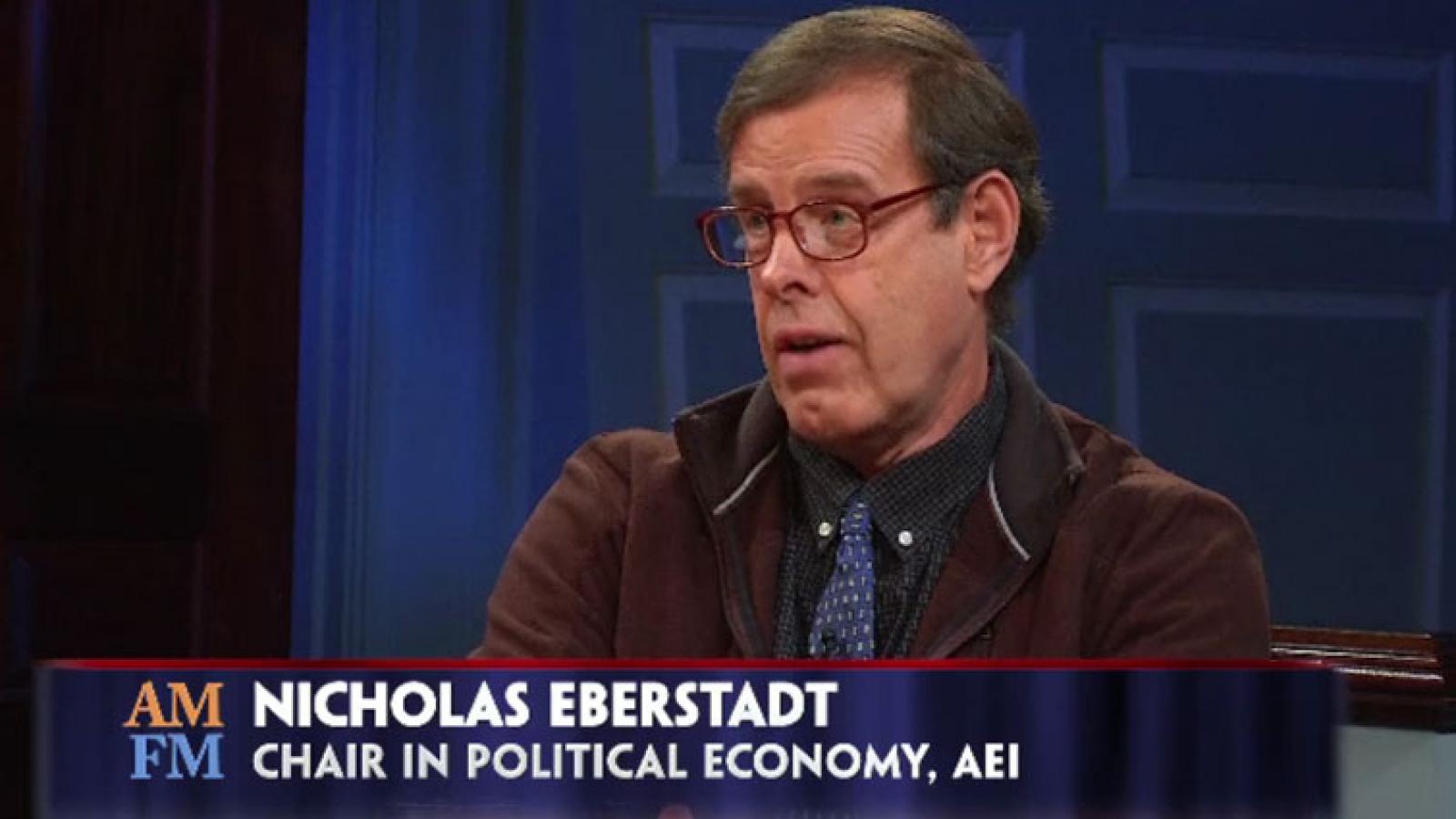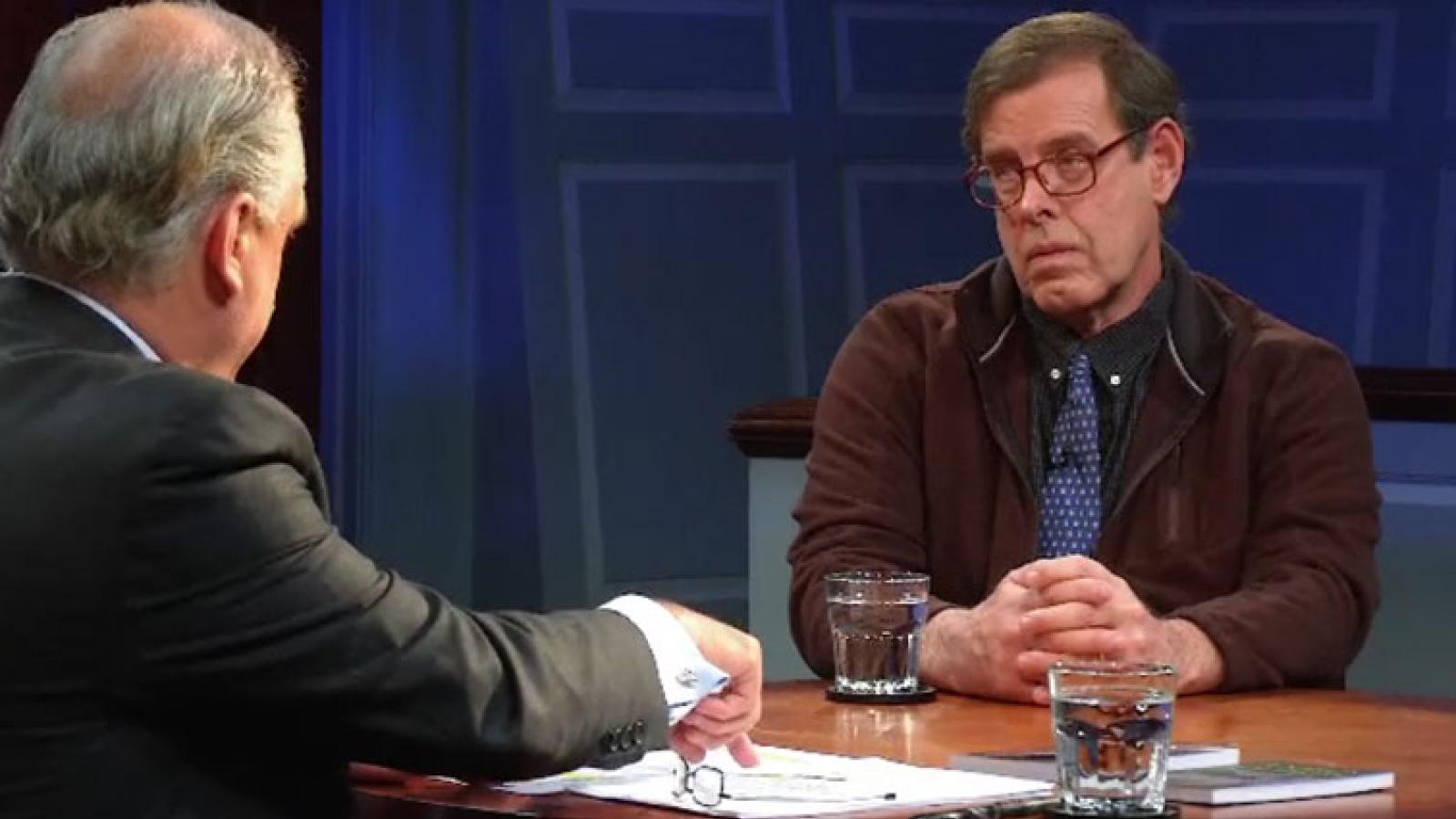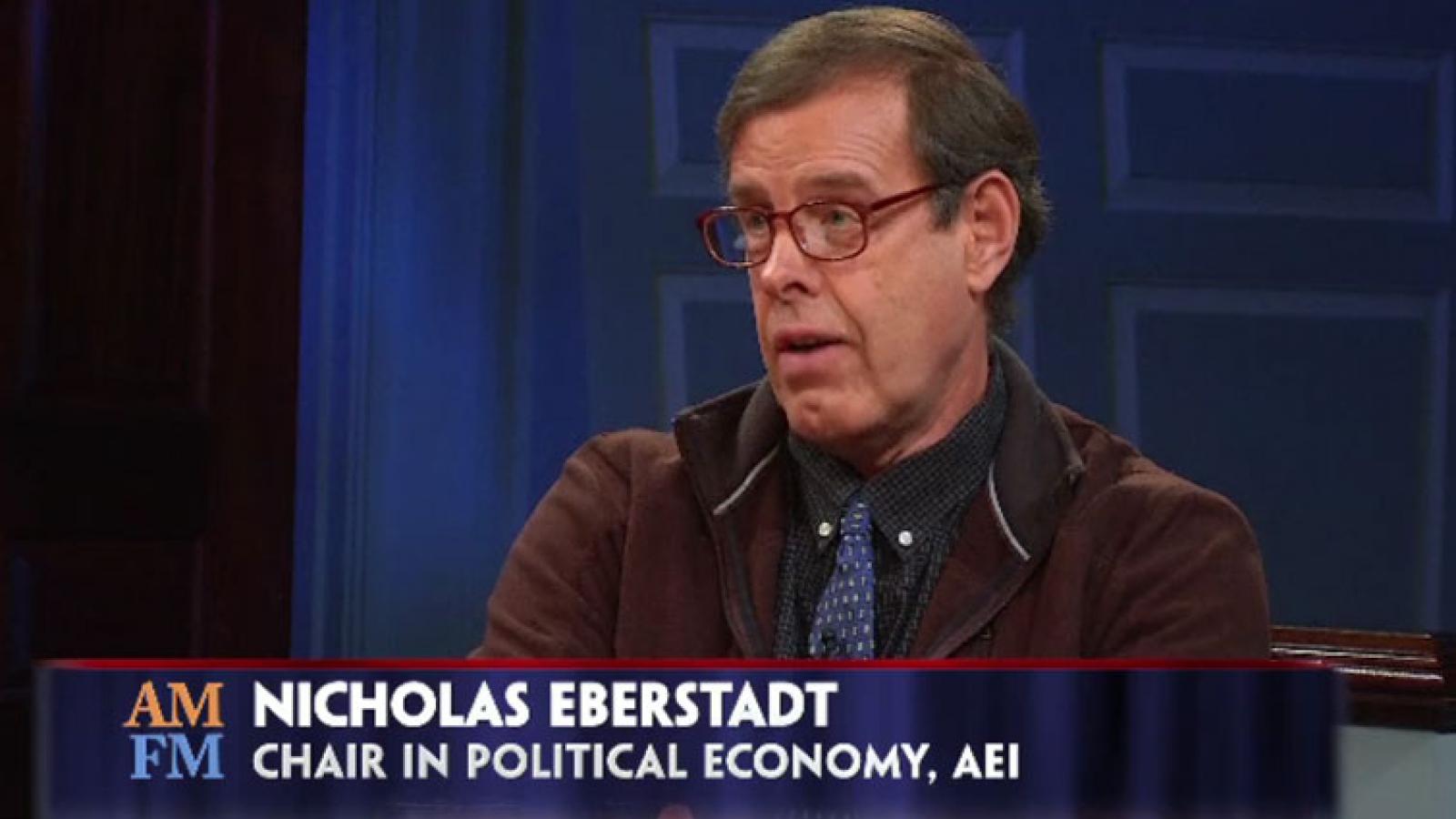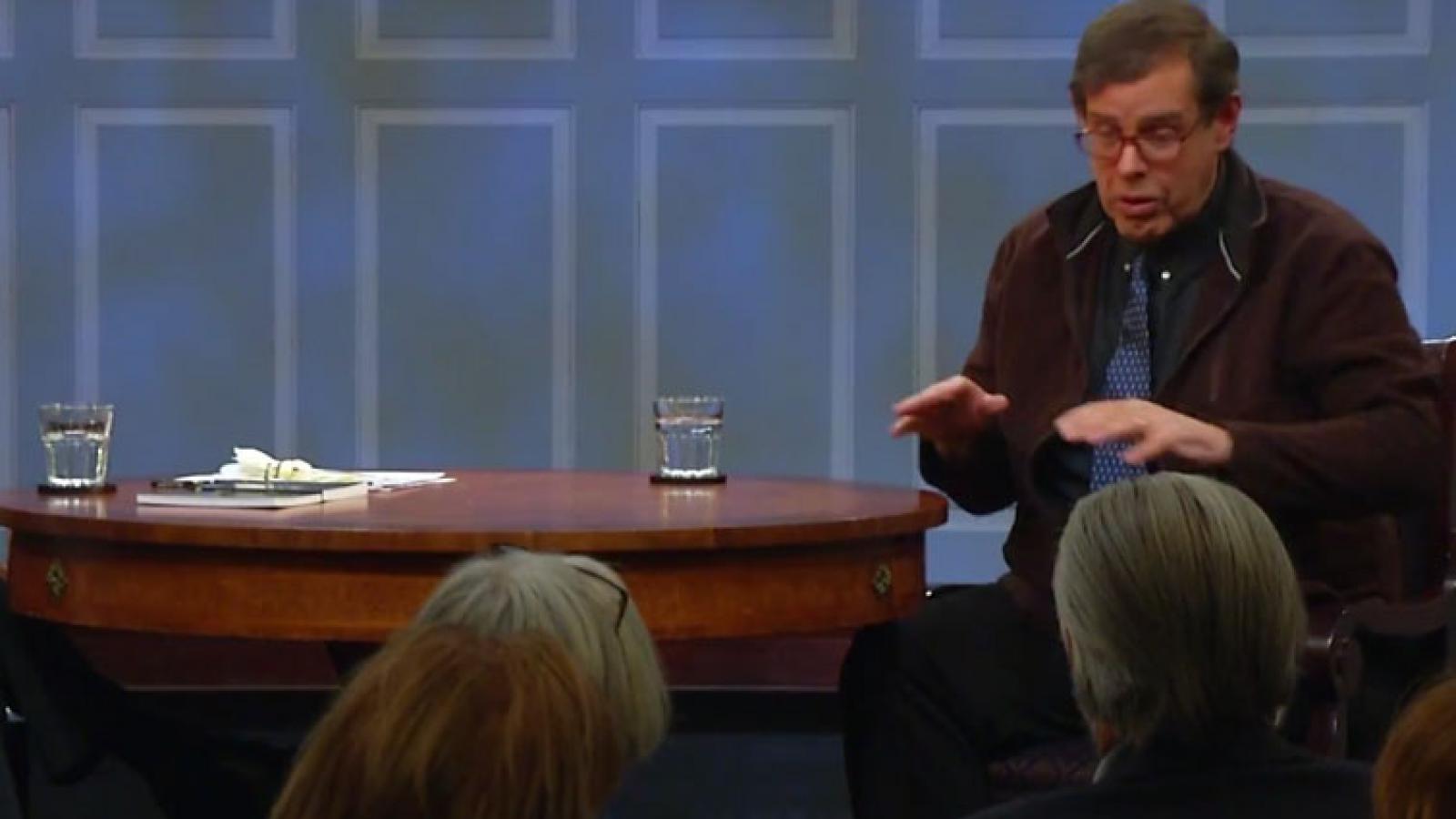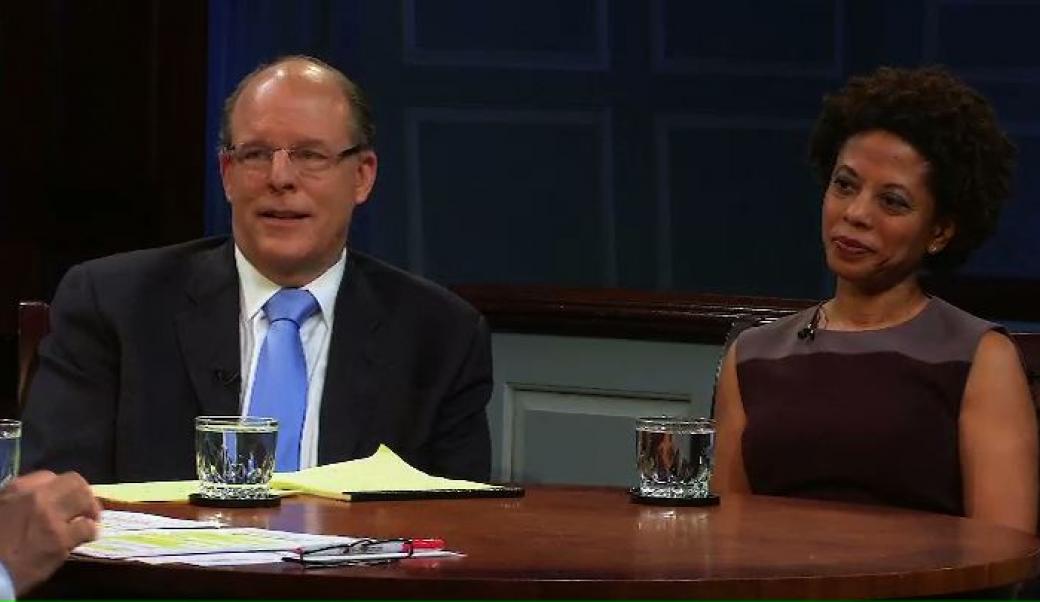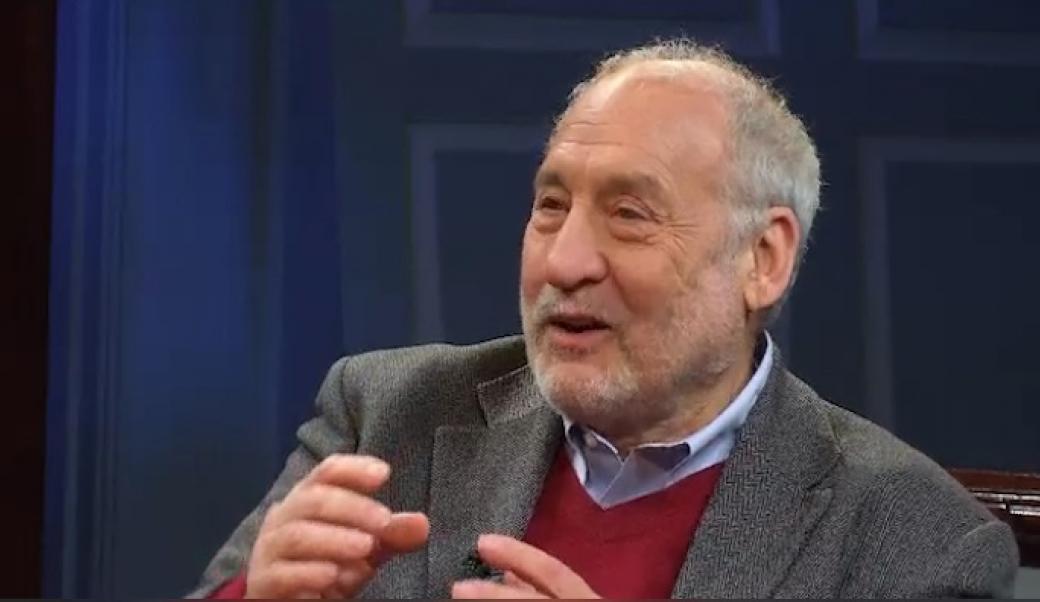About this episode
April 02, 2017
Nicholas Eberstadt
With the election of Donald Trump, Americans have continued to focus on the deep divide between the haves and the have-nots in the nation. In this episode, Nicholas Eberstadt, a resident scholar at the American Enterprise Institute and author of "Men Without Work: America’s Invisible Crisis," looks beyond low unemployment numbers to assess the anxieties of the white working class in America. What is going wrong? And what can our new president do about it?
Jobs and Economy
First Year 2017: Opportunity and the white working class
Transcript
Doug Blackmon: Welcome to American Forum. I’m Doug Blackmon. This week, a look behind the headlines at a group many believe gave Donald Trump his presidential win.
AMERICAN FORUM INTRO TITLES/MAIN THEME
0:53 Doug Blackmon: The election of Donald Trump sent pollsters and demographers scrambling to determine the answer to this question: Who voted for Donald Trump? Was there just one demographic group responsible responsible for his surprise victory? Or is the answer not so simple? One thing is for sure, there is a deep divide in this country between the haves and the have-nots and, to some degree, that divide was reflected in this election. Over the past year the Miller Center has been gathering experts to give non-partisan advice about major issues certain to confront the nation in the first year of this new presidency. There may be no issue bigger or more urgent than anxieties about the economic future of working class Americans.
THE QUESTION: Why are working class voters really so angry?
One way to better understand all this, is to look at unemployment.
That must be good news, right? Because unemployment currently stands at 4.7 percent.
But is that really the complete story? Our guest in this episode says it's not. He argues that the U.S. has suffered something akin to a decimation of its male workforce over the past 50 years, that we are short of full employment by nearly 10 million male workers. Nicholas Eberstadt is a resident scholar at the American Enterprise Institute, the Washington think tank better known as AEI. His most recent book is Men Without Work: America’s Invisible Crisis. Previously he wrote A Nation of Takers: America’s Entitlement Epidemic.
2:18 Blackmon: Let’s talk right off the bat, about those unemployment numbers [Eberstadt: Sure.] that I just cited.
FACTOID: unemployment rate was 7.8% when Obama was inaugurated in 2009
How can it be that an unemployment rate of 4.7 percent, which is a huge improvement over what it was seven years ago, there’s no disputing that, but you say that the idea that President Trump inherited a solid economy or that things are going generally in the right direction, I think you’ve said that’s nonsense. So how can that be?
Nicholas Eberstadt: If we were still living in a Dickensian universe, where there were only two options when you were of working age, either to have a job or to be looking for one, then the employment rate would be a perfect indicator of the stress, but things aren’t that simple any more. There are now three statuses that you can have if you’re of working age. You can either have a job, you can be unemployed and looking for a job, or you can be checked out from the workforce altogether, and over the past 50 years, the very fastest growing segment of so-called working age men, has been the out of labor force, unworking, neither working nor looking for work guys. For every guy today in that prime group you mentioned, who is unemployed, there are three who are neither working or looking for work. So if you just look at the unemployment rate, you’re chasing the wrong rabbit.
3:34 Blackmon: For every male in that prime working group, so we’re not talking about high school kids or college kids [Eberstadt: No.] or retirees, but these men, who are in that 25-year period.
Eberstadt: Critical age group, backbone of the labor force, the ones that the labor economists and the people on Wall Street always look at. For every guy who is formally unemployed, there are three guys who are neither working nor looking for work, so they’re out of the equation altogether, that unemployment is calculated on the basis of.
4:05 Blackmon: Yeah, fascinating. Now, President Trump, there was a stir of reaction when President Trump has said a number of times, in different ways, he has thrown out gigantic numbers, saying the real unemployment of the country is vast and often is this much higher number than the official numbers, and the reaction to that typically has been oh, he’s counting all of these categories that shouldn’t be counted. [Eberstadt: Sure.] But so your number though, that you’re talking about, is not the same as what he’s saying.
Eberstadt: No. What I’m trying to do is an apples to apples comparison that lets us take a look at what’s happened over time and over historical time. And if you take a look, let’s say, only at the people who are employed, only at the people with jobs, employment to population ratio or work rate, the work rate for these 25 to 54 year-old American men is lower today than it was in 1940, at the tail end of the Depression. So it’s not hyperbolic to say that this is a depression scale crisis for working age men.
5:07 Blackmon: Why then, are we not in a depression-like environment? Why doesn’t it feel like we’re in a depression?
Eberstadt: We’re a vastly more affluent society than we were in 1940 and in fact, even since the year 2000, net wealth in the United States has more than doubled, so some people have a whole lot of good times going on. We also have women in the workforce in a way that clearly wasn’t the case back before World War II. One of the big stories for all western economies in the postwar era, was the entry of women into paid work. I mean women always worked, it’s just that after World War II, they got paid for it. That’s been an important factor there.
FACTOID: 1950-2000: Share of women in the workforce increased from 30-47%
5:52 Blackmon: Yeah and so, and the men then, that we’re talking about, who are not working, and particularly those who are not seeking work, if we try to figure out who they are. And so some of them are just, they’re just not working, right, they’re just, they’re at home watching TV, right?
Eberstadt: Well, about one in seven of this seven million pool you mentioned, say they’re out of the labor force because they can’t find work, that’s the classic definition of a discouraged worker, but the overwhelming majority do not say that it is because of want of employment, it’s other reason that they give. Some of those other men out of the workforce are adult students. They’re basically pursuing education as if it were a job, that are ready to get back into the game. But there’s an enormous group, many, many millions, who are in what the Brits would call NEET, N-E-E-T, neither employed nor in education and training, and that’s a group which is in absolute, I think desolation and despair today.
6:57 Blackmon: And there are also not—I mean it may be that the reason they are not starving, is because there is another person in their unit, probably a wife or a woman who they’re not married to, but it’s somebody who does have an income of some sort and that’s why they’re not in even more desperate straits. But these men are not necessarily watching the kids or sort of—it’s not a complete reversal of roles, but the critical thing is that there is another person in this family, probably a woman, who is actually working.
EBERSTADT: It’s almost necessarily that they’re not watching the kids. I mean, there is an astonishing care chasm between women who are not in the labor force and men who are not in the labor force. The men who are not in the labor force and say they’re at home because they’re watching kids or somebody else, is almost a rounding error, I mean it approximates zero.
7:44 Blackmon: So when you survey these very people and you say well what are you doing when you’re not working, there’s not half of them saying yeah, I’m helping out, I’m taking care of the kids and getting the laundry done. They don’t say that.
Eberstadt: No. It’s really distressing, to see the self-reported answers on what the guys who are out of the labor force, neither in employment, education or training, do with their time. They basically say they don’t do civil society, they don’t attend religious worship, they don’t do charitable work, they’re not part of civil society. What they say they do is watch. They say they watch TV, they say they watch Internet, handheld devices, as if it were a full-time job, 2,100 hours a year, is what they report.
FACTOID: Since 1948, share of men over 19 without work has risen to near 32%
8:32 Blackmon: And there’s one data point here, that about half of these men from surveys indicated they took painkillers the previous day.
Eberstadt: Yeah, yeah. Professor Alan Krueger at Princeton published a study last year that reported this, so it’s not just spending all day watching TV, it’s spending all day watching TV stoned.
Blackmon: Wow. I mean your work is fundamentally about the working class, but are there racial distinctions within this, that have some sort of meaningful—some usefulness?
Eberstadt: Sure. Well I mean, if you’re talking about a group of seven million guys, you obviously have pretty much some of everybody in it, but there are people who are overrepresented. African Americans are overrepresented, guys with less education, especially guys without a high school degree, are overrepresented. Guys who have never been married are overrepresented and interestingly enough, guys who were born in America, as opposed to being immigrants, are overrepresented. That’s true for every ethnic group within the composition. But some of these things are crosscutting. For instance, if you are a white guy who has never been married, you’re more likely to be in this pool than a black guy who is married. Workforce participation rates for African American guys who are married, are higher than for white guys who have never been married. So there’s some individual agency in this also.
10:02 Blackmon: If we look at these numbers, if you showed them to a group of African Americans and you said hey, look at this, here’s a phenomenon where—and if you separate it out, the white guys in this group, and you said look at this entrenched phenomenon that has developed with these white male workers and these higher than you would expect levels of unemployment, and these kinds of behaviors, and the frustrations that they feel, I think a lot of African Americans would say welcome to the club. [Eberstadt: Sure.] You know, this is what we’ve been stuck in, or versions of this, for a very, very long time. And so this is something that I sometimes think about as the democratization of poverty, but this idea that where we once were a society that had sort of designated the back people, which were then the only major minority, but that sort of black people were the permanent underclass, and as the system became more fair in a sense, that what we’ve actually done is extend the dimensions of economy and our society that seem to create this vulnerability. Well that’s now something that the white males are subject to, not just African Americans. Is there any logic to that?
Eberstadt: I think there’s an immense amount of logic to that. You recall that back about half a century ago, a little bit more than half a century ago, the late Senator Daniel Patrick Moynihan did this then electric, electrifying report, in language of those days, “The Negro Family in America: A Case for National Action,” about black family disintegration in America. He was absolutely alarmed, because it turned out that at that time, about one in four African American children was being raised in a single parent home. Today for Anglos, for non-Hispanic whites, the proportion of children born out of marriage is almost 30 percent. It’s higher than what alarmed Moynihan about African American community in America half a century ago. When he wrote that report, he thought that the unique oppression that African Americans had suffered, would explain the family breakdown. It turned out instead, that African Americans were just sort of a leading indicator for things that were going to be happening in the rest of America over the decades after that. The family disintegration, increasing welfare dependence, crime to some degree, but leading indicator, very much a part of society but a leading indicator, not an exceptional group.
FACTOID: African American unemployment was 9.5% in 2015, 4.5% for whites
If you look at West Virginia, you’ll see that that state has got the highest proportion of men of working ages not employed, of any state in the nation, no surprise, for the reasons that you’ve mentioned.
FACTOID: West Virginia’s unemployment rate hit a high of 8.8% in 2010
But what we see across the country over the past generation, is that the gaps between different states in the U.S., the work rates of different states, are getting more and more disparate. I mean, when I took economics, back in the stone age, they told me that labor markets tended to equalize over time. We’re seeing exactly the opposite occurring in the U.S., and I don’t think you can explain that just in terms of technological change, globalization. There are other things that are going on, maybe we’re not attuned to them as well as we should be.
13:29 Blackmon: And what are those? I mean, are we talking about work ethics?
Eberstadt: I’ll mention two things, I’ll mention two things, because I think the government does a really rotten job of tracking both of these. One is the explosion of disability insurance payments as an alternative to working life in America today. Living on disability sure isn’t a great lifestyle, it’s not going to make you live like a prince, but more and more people are in this disability financed lifestyle. At this point about three out of five of those prime aged men are receiving one or more disability pension. The second thing that we don’t talk much about is the criminalization or criminality of the U.S. population. We talk about mass incarceration and we know that there are millions and millions of men behind bars. What we don’t seem to pay any attention to is that there are vastly more men who have been sentenced, who have been felonized, in our society as a whole, than behind bars. At this point in time, there are probably about 20 million American men and women, obviously mostly men, who have a felony in their background and are not behind bars, that’s one out of eight guys in America today. The government kind of forgot to collect any information about this, so the government can’t tell you what their work profiles are like, but that’s got to be one of the reasons the U.S. work profile and labor force participation profile is so much more disappointing than in other rich countries today.
15:10 Blackmon: We’re stuck, I think, most Americans are stuck on a view of society about who is performing and who is not. That’s sort of an early ’70s picture, and it’s a picture that says lots of African American men are not in the workforce and maybe aren’t trying to work, and maybe are living off a woman, maybe they have some sort of government entitlement is the key element of their equation, and not marrying, lots of African American children being born out of wedlock, and teenage African American girls having way too many babies. That’s kind of the stereotypical picture and we see that as things that are largely located in the African American community.
FACTOID: African American teen pregnancy rates dropped by 44% between 2006-2016
But if you look at the recent data of course, what you see is that teen pregnancy among African American girls has fallen precipitously over the last ten years. The fastest rising group being incarcerated, I think the fastest growth, is actually, just off of such a small base, are actually white females, but also all these numbers of the declining performance of white males.
Eberstadt: The big story of social dysfunction in the last ten or fifteen years, maybe the Anglo, the non-Hispanic white heroin epidemic and painkiller epidemic. When I was my children’s age, if you talked about people who were addicted to opioids, it was a ghetto minority stereotype. What’s happened over the last 20 years is that painkiller and heroin addiction has gone mainstream, main street, and it’s grown disproportionately among the so-called Anglo population, which is why deaths from overdoses, different types of overdoses, can now, on a national scale, be higher than deaths from traffic accidents or gunshots, and this is a white thing.
FACTOID: According to CDC, 91 Americans die each day from opioid overdose
17:10 Blackmon: Yeah. That’s astonishing really, but it’s also weird, you know it’s strange, though. It’s astonishing but it’s also, it’s that our society has become more fair, and really terrible things now, are more fairly distributed.
Eberstadt: Equal opportunity to disaster. One of the things which has happened over the last 15 or 20 years, which I think is quite eerie, has been the end of health progress for the Anglo population in America, and the rise and death rates for less educated whites. Anne Case and Angus Deaton, both Princeton, did a stunning study a couple of years ago, documenting this. Why are death rates rising for less educated white men and women between 45 and 54, when they’re improving more or less everywhere else in the world? Suicide, poisoning, overdoses and cirrhosis of the liver; these are deaths of despair, it’s heartrending.
18:17 Blackmon: But even beyond that what are the big implications of this for society?
Eberstadt: Sure. Since the year 2000, personal wealth in our country has more than doubled and over that same period of time, the bottom has dropped out in the labor force. If we had the same work rates today as in the year 2000, we’d have ten million more people in America with paid work. So, we live in this era when there is more wealth for the wealth holders and less work for the workers. I mean, if you wanted to set the stage for a populist storm, I don’t know how you could do much better than that.
18:55 Blackmon: But does that mean that if these trends continue, we ultimately consume that wealth?
Eberstadt: Certainly it is true that if the economy picks up, and we have had, I suppose the charitable word for it is mediocre, economy, since about the year 2000, if the economy picks up, it’s going to bring back some of the men, and now the women, because the work rates have started to drop for women as well since the year 2000. It will bring some of them back, but there are other people that I don’t think are going to be rescued just by the miracle of the market. These are the people who are trapped in the disability support lifestyle, who have gotten into Medicaid financed painkiller addition, the people who have the felonies in their background. I think we’re going to have to do something that actually suggests that they matter to us, if we’re going to try to bring them back into the rest of society.
19:51 Blackmon: What would that look like, a kind of response that might change this? Whether it’s actually repairing the broken people who are currently broken, or even if it’s just how do we make this population not get any bigger, how do we make the next generation better. Is the solution what President Trump is talking about, tariffs at the border? Is it his recipe or is it something else?
Eberstadt: Well, my personal tragic disability is that I was trained in economics, and what I learned in economics was that if you want to get rid of all of the rest of the manufacturing jobs, you might as well have a great big trade war right now, because that will do it.
FACTOID: Manufacturing and construction accounted for 40% of jobs in 1950s
That’s a way that everybody loses. I think what we need to do is get the escalator moving again. I mean, the escalator is working pretty well for one stratum of America, but it’s obviously not working for a whole lot of other Americans. And I don’t have the ten point program or the twelve step program, or whatever we talk about for that, to make this happen, but I can see we clearly need to have more generation of jobs by smaller businesses. Small businesses are the heart and soul of job generation in America.
FACTOID: Rate of new business creation collapsed by 30% during recession
We’ve lived in a net business death environment since about the year 2007, more businesses closing than opening. We need to have a lot more mobility. The churning is good, not bad. The churning is good. Leaving jobs and going to new jobs is good, that’s mobility. We’ve got less geographic and also labor force mobility, than we had 30 years ago. We’ve got to do something about this trap of disability insurance. We need to have a reform that leads to a work first principle in social welfare policy and finally, we can’t pretend that the 20 million Americans in our country who had trouble with the law some time, don’t exist. We’re supposed to be a forgiving society. If people have paid their debt to society, we’ve got to figure out how to get them back in society and back in the economy. We can’t have evidence based policies if we don’t have the evidence, and the government is closing its eyes towards these 20 million people.
22:05 Blackmon: I know you said you don’t have the ten point plan, but is it basic stuff like that, is it going back to education?
Eberstadt: There are some things that the government can’t do. The government can’t repair the American family and family structure matters immensely to social and economic outcomes. We don’t know how to do that. I mean maybe if there were some sort of John Wesley style awakening in America, that could make some sort of a big difference, but I sure wouldn’t want to government to have the department of Methodism, right, I mean you don’t want to have something like that. What the government can do is with education and educational attainment improvement in our country has stalled. It has stalled for more than a decade, it stalled for a couple of decades, and the quality of K-12 education in America, I think might charitably be described as mixed at the moment. Not everybody needs to go to college but everybody needs a skill, and we need to have a system of education, not just for the kids who are in school, but also for people of current working age, that replenishes or enhances their skills, because it’s the skills which are going to be the key to the escalator, I think.
23:24 Blackmon: So, I don’t know if you’ve had a chance to give your best advice to President Trump directly yet.
Eberstadt: By Twitter?
Blackmon: By Twitter or any other means.
Eberstadt: I don’t use Twitter.
Blackmon: But if you had the chance, if it so happened that President Trump, in the middle of the night, watched the show that we’ve taped today, and said okay, I want to actually talk to that guy, and called you in and you had ten minutes or even less than ten minutes, but basically Donald Trump said okay, you know, you’re such a smart guy, you tell me, where do I start in terms of dealing with this group of people, a lot of whom did vote for me, but whose lives I actually do want to change, I want to see different? What’s the first thing you would say to him, either to say here’s where you’re going wrong or here’s the thing you really ought to be doing?
Eberstadt: I guess the very first thing that I would say is look at the 20 million invisibles, get the numbers that you need to see how the 20 million invisible people, with the felonies in their backgrounds, are doing, to help them reenter society. if I was able to get to the second floor in the elevator conversation, then I’d talk about reforming disability insurance. If we had another floor, revitalizing small business in the United States.
24:42 Blackmon: This is a conversation that, as is almost always the case, it’s a lot more complicated than we want it to be. In understanding any of these issues and understanding things as basic as why somebody won a particular election, but I think this kind of insight into a group of people that it’s true, whether we’re in a bubble or not, that most Americans kind of just don’t want to hear about, if they’re not part of it, who just don’t want to hear about this, and that’s a long pattern in American history, of us just not wanting to hear about a problematic cohort of the population, so thank you.
Eberstadt: Thank you so much for inviting me.
25:15 Blackmon: We hope you’ll join us for future editions of American Forum, where our focus is always on the presidency and the challenges it faces. Coming up in future episodes, Nobel Prize winning economist Joseph Stiglitz, and Bill Clinton’s speechwriter, now citizen power activist, Eric Liu. You can watch us on your local public television affiliate, or to join our ongoing conversation, look for us on the Miller Center Facebook page, visit millercenter.org, or follow us on Twitter. My handle is @douglasblackmon. See you next week.
